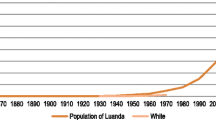Abstract
This article examines the idea of ‘flexibility’ within the context of a city. It uses the idea of livelihoods to contribute to the debates on flexibility, particularly on the role that ordinary people play in the transformative potential of cities. A closer examination of ordinary people’s activities show that although livelihoods are crucial to how they adapt to the changing social and economic conditions, such activities largely constitute survival strategies. Importantly, and without subscribing to a paradigm that promotes a city as a closed space, the continuing socio-spatial divisions in the city of Rustenburg, South Africa underscore the fact that ordinary people’s remarkable resourcefulness occurs under circumstances of marginality.

Similar content being viewed by others
Notes
The term ‘ordinary people’ will be used interchangeably with ‘the poor’ because the latter can move in and out of poverty, depending on a portfolio of assets ordinary people have been able to amass at particular places and times.
Apart from the last page of this article where I referred to the minutes of the Rustenburg City Council, the statements made here are a compilation of interviews from the unemployed people of the three neighborhoods I have mentioned. Some of the informants are former mineworkers who were active in the labor movement. The other informants were active members in the Freedom Park Development Forum as well as Freedom Park Housing Committee. The Catholic Church has also provided useful information.
US$1 = R5 at that time.
References
Allen, J., & Henry, N. (1997). Ulrich beck’s risk society at work: Labor and employment in the contract service industries. Transactions of the Institute of British Geographers, 22, 180–196.
Bevan, P. (2004). Exploring the structured dynamics of chronic poverty: A sociological approach, University of Birmingham, ESRC research group on wellbeing in developing countries, working paper 06.
Chambers, R. (1995). Poverty and livelihoods: Whose reality counts?. Environment and Urbanization, 7, 173–204.
Cosgrove, D., & Jackson, P. (1987). New directions in cultural geography. Area, 19, 95–101.
Du Toit, A. (2005). Poverty measurement blues: Some reflections on the space for understanding ‘chronic’ and ‘structural’ poverty in South Africa, chronic poverty research centre, working paper no. 55.
Katz, C. (2004). Growing up global: Restructuring and children’s everyday lives. Minneapolis: University of Minnesota Press.
Lees, R. (2004). Introduction. In L. Lees (Ed.), Emancipatory Cities. London: Sage.
Meagher, K. (2001). Throwing out the baby to keep the bathwater: Informal cross-border trade and regional integration in West Africa. In regionalism and regional integration in Africa. A debate of current aspects and issues, discussion paper 11. Uppsala: Nordiska Afrikainstitutet.
Mitchell, T. (2007). The properties of markets. In D. MacKenzie, F. Muniesa, & L. Siu (Eds.), Do economists make markets? on the performance of economics (pp. 244–275). Princeton: Princeton University Press.
Piore, M., & Sabel, S. (1984). The second industrial divide: Possibilities for prosperity. New York: Basic Books.
Peberdy, S., & Rogerson, C. (2003). South Africa: Creating new spaces? In R. Kloosterman & J. Rath (Eds.), Immigrant entrepreneurs: Venturing abroad in the age of globalization (pp. 79–99). Oxford: Berg.
Reimer, S. (2005). Flexibility. In D. Atkinson, P. Jackson, D. Sibley, & N. Washbourne (Eds.), Cultural geography: A critical dictionary of key concepts (pp. 80–86). London: I·B. Tauris.
Robinson, J. (2004). The urban basis of emancipation: Spatial theory and the city in South African politics. In L. Loretta (Ed.), Emancipatory cities (pp. 161–177). London: Sage.
Acknowledgements
I am grateful to two anonymous reviewers for helpful comments. I appreciate the time and insights of my informants in Rustenburg. All errors and omissions remain the responsibility of the author.
Author information
Authors and Affiliations
Corresponding author
Rights and permissions
About this article
Cite this article
Mosiane, B. Landscapes of flexibility or landscapes of marginality? spaces of livelihood formation in a changing South African city. GeoJournal 74, 541–549 (2009). https://doi.org/10.1007/s10708-008-9247-4
Published:
Issue Date:
DOI: https://doi.org/10.1007/s10708-008-9247-4




